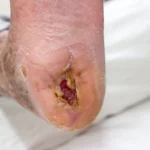The Transformative Role of AI in Clinical Trials
Mar 22, 2025Navigating Greek Life in College with Type 1
Jan 15, 2025The Awesomeness of the Patient Professor Academy
Dec 23, 2024Giving Thanks
Nov 23, 2024Honey Bee Venom in Clinical Research
- Melissa Huettner
- 6 Minutes Read Time
Bee venom, a substance long revered in traditional medicine, is making waves in modern clinical research. Its potential applications range from treating chronic diseases to combating infections and even reducing cancer cells. Honeybee venom has been used since 460 BCE Hippocrates used bee stings as therapy also known as Apitherapy.
What is Bee Venom?
Bee venom is a complex mixture of proteins, peptides, and enzymes produced by honeybees (Apis mellifera). The most studied components include melittin, phospholipase A2, and hyaluronidase. Melittin, in particular, has gained attention for its ability to induce inflammation and destroy cellular membranes, properties that researchers are now harnessing for various therapeutic purposes.
Clinical Trials and Research Focus

According to clinicaltrials.gov, approximately 40 clinical trials have been conducted using bee venom. The trials have mostly been conducted in countries other than the United States. Below are the conditions that can be treated with bee venom and clinical trials associated with the conditions.
- Anti-Cancer Therapy
One of the most promising areas of bee venom research is its potential in cancer treatment. Melittin, the main active compound in bee venom, has shown the ability to target and kill cancer cells without affecting healthy cells. This selective toxicity is attributed to melittin’s ability to disrupt cancer cell membranes.
Recent clinical trials are investigating the efficacy of bee venom-derived compounds in treating various cancers, including breast cancer, prostate cancer, and leukemia. Preliminary studies suggest that these compounds might enhance the effectiveness of conventional treatments like chemotherapy and radiotherapy while reducing their side effects.
- Anti-inflammatory and Pain Relief
Research indicates that bee venom’s anti-inflammatory properties could be beneficial in treating autoimmune diseases and chronic pain conditions. Trials focusing on the use of bee venom injections to alleviate symptoms and improve the quality of life for patients with arthritis and other inflammatory disorders.
- Antimicrobial and Antiviral Properties
Bee venom exhibits notable antimicrobial and antiviral activity, which has led researchers to explore its potential in treating infections. Studies are investigating how bee venom can combat antibiotic-resistant bacteria and viruses, including those that cause severe respiratory infections and skin conditions.
- Effects
Currently, there are few or no effective options available for the treatment of acute and chronic neurodegenerative diseases. A characteristic of many neurodegenerative diseases — which include stroke, brain trauma, spinal cord injury, amyotrophic lateral sclerosis, Huntington’s disease, Alzheimer’s disease, and Parkinson’s disease — is neuronal cell death. Given that central nervous system tissue has very limited, if any, regenerative capacity, it is of utmost importance to limit the damage caused by neuronal death. Bee venom consists of several biologically active peptides, and it contains a variety of molecules that act as mediators between the immune system and the nervous system. These molecules facilitate nerve transmission and healing in a variety of nerve disorders. This gives bee venom the ability to travel along the neural pathways from the spine to various trigger points and injured areas to help repair nerve damage and restore mobility.
Completed Trials
Bee Venom for the Treatment of Parkinson’s Disease France Phase 2 Study completed in 2013
The purpose of this study is to evaluate the efficacy of repeated (monthly) injections of bee venom on motor symptoms of Parkinson’s disease over a period of one year, as well as the potential effects of this treatment on disease progression compared to placebo (saline injections).
Efficacy and Safety of a Purified Standardised Bee Venom Preparation Germany Phase 3 Completed 2010
The trial is performed to assess the efficacy and safety of a purified standardized bee venom preparation in bee venom allergy
Bee Venom Acupuncture for the Treatment of Frozen Shoulder Korea Phase 2 Completed in 2010The purpose of this study is to evaluate the effectiveness of combined bee venom acupuncture (BVA) and physiotherapy (PT) on frozen shoulder, and whether if the effect of BVA is dose-effective.
Effect of Bee Venom Phonophoresis on Healing of Chronic Lower Limb Ulcers Egypt Completed 2022 Bee venom (BV) phonophoresis has been suggested as a noninvasive treatment for a number of inflammatory conditions and in the healing of ulcers.

Challenges and Considerations
While the potential of bee venom is promising, several challenges must be addressed:
- Safety: Bee venom is known to cause allergic reactions in some individuals. Clinical trials must ensure that treatments are safe and effective without inducing severe allergic responses. Side effects include pain and itching, death, and allergic reactions. Patients have to be tested for allergies to bees prior to the trial.
- Standardization: Bee venom’s composition can vary depending on the source and preparation methods. Consistent and standardized preparations are essential for reliable trial outcomes.
- Ethical and Environmental Concerns: Harvesting bee venom must be done in a manner that ensures the health and welfare of bee populations, which are already under threat from various environmental factors.
Bees are killed when they sting. The stinger of a honey bee is connected to the venom sac, the venom gland, and the Dufour’s gland inside its body. The outside end of the stinger is barbed. When a bee stings, the barbed sting becomes lodged to its victim. When the bee moves away the stinger pulls the venom sac and the glands sting becomes lodged to its victim. When the bee moves away the stinger pulls the venom sac and the glands out of their body which leads to the death of the bee. Much research has been conducted to safely remove the bee venom without harming the bee. An inventor in Australia invented a plate with music strings to extract venom. Bee whisperer. This device does not hurt bees. The plate vibrates causing them to get upset and sting the glass on top. This does not hurt them or kill them as the barbs on their stingers do not get caught in anything. The venom deposits onto the glass and dries. Once you have collected the venom, you remove the plate and scrape it to get the dried venom off and into a jar.
The future of research
As clinical trials continue, the hope is that bee venom will find its place as a valuable therapeutic tool. Researchers are optimistic that ongoing studies will provide deeper insights into its mechanisms and broaden its applications.
Bee venom represents an exciting frontier in medical research. With continued investigation and careful consideration of safety and efficacy, it holds the potential to offer new therapeutic options and enhance our ability to treat a range of diseases.
Melissa is the Global Digital Strategy Lead for Interim Visits Magazine. She is an experienced CRA and Clinical Research Coordinator with experience in several therapeutic areas including oncology and ophthalmology.
Melissa is an experienced Clinical Research Associate (CRA) with experience in numerous therapeutic areas including ophthalmology, endocrinology and oncology. Melissa is also the Associate Editor of Interim Visits Magazine.
Outside of clinical research, Melissa is a beekeeper. She is the owner and manager her family’s apiary. Rabbit Hole Farms, in Eastern Tennessee. She eventually hopes to collaborate on clinical trials related to medicinal honey, bee venom, and/or bee allergies.

















